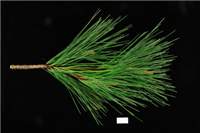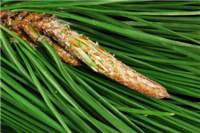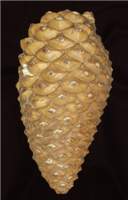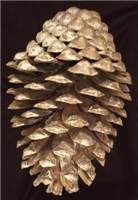Name
Pinus radiata D.Don, Trans. Linn. Soc. London 17,3: 442 (1836).[Radiata pine]
Description
Habit: Large evergreen tree up to 55 m in height, rarely exceeding 60 m with dbh to just over 2 m. Young trees generally have irregular crowns with strongly pointed tops, but the crown eventually becomes rounded or even flattened at the top in old trees. Crowns are generally very dense in open-grown trees but lighter in plantation-grown trees. Mature crown form can vary widely between individual trees. General tree form is also extremely variable between sites ranging from narrow spire-like crowns with straight stems and little taper on infertile soils to squat crowns with heavy branching, crooked stems, strong taper and frequent forking on certain very fertile sites where habit varies between individuals. Branching is usually polycyclic (multinodal) to varying degrees, with several clusters of branches produced on a year’s growth of the leader. Intervals between branch clusters on the bole are thus highly variable on all sites and often rather irregular, while branch size can vary markedly from cluster to cluster. Prominent cones generally persist for many years on the leading shoot and major branches.
Bark: Thin and brown for the first 5-6 years, then developing deep, mainly vertical fissures, quite hard, and sometimes becoming thick (up to 5 cm or so) on large, vigorously growing trees. The fissured bark generally turns a dark grey or grey brown, and does not flake readily unless very exposed to the sun. Fissures reddish on vigorous trees reflecting the rich brownish red of freshly cut bark surfaces. Bark becomes much thinner and less fissured up the stem and beyond the first 5 m or so. The island populations develop the thick fissured bark much more slowly.
Foliage: Needles generally in threes in mainland Californian populations (and mainland-island hybrids), in pairs in island populations, but can occur in large numbers (up to six or more) on large, vigorous shoots of young trees. Typically in threes in New Zealand stock reflecting its Californian mainland ancestry, vary occasional trees having two-needled fascicles. Usually 10-18 cm long, occasionally 3-20 cm, 1.2-2 mm wide, typically intense, dark green but may be yellowish or bluish green. Needles generally soft and moderately pliable, not drooping, often bent near base, sometimes twisted. Leaf sheaths persistent, 8-12 mm long at first, becoming shorter.
Branchlets: Pale green at first, soon becoming yellowish brown eventually greyish brown, without hairs, ridged and furrowed with persistent leaf bases. Fairly thin for a pine (typically 5-8 mm diameter).
Winter buds: Cylindric or cylindric-ovoid, abruptly pointed, usually chestnut brown but sometimes with whitish scales appressed thinly resinous. On large shoots the buds may be compound, the buds of branches being clearly evident within the overall bud structure.
Male cones: In clusters at base of emerging shoots, cylindrical, 7-17 mm long, yellowish when pollen is ripe. The time of pollen shed varies with site and individual trees, ranging from mid-July for some trees on the warmer North Island sites, but generally peaking around mid-August.
Female cones: Usually in clusters of three to five or more but sometimes solitary, stalkless or with short stalks, and serotinous (remaining closed on the tree after ripening, sometimes for many years in cool humid situations). Emergent conelets reddish purple becoming medium to dark green after the pollination, ripening to pale or medium brown over an extended period starting in the second spring after pollination, and weathering to grey-brown. Size and shape highly variable. Length 7-17 cm in New Zealand: width 4-7 cm (occasionally up to 9 cm) when closed. Shape ovoid-conical, generally with strong asymmetry associated with curvature back from shoot tip; this curvature ranging from 20°-90° (average about 50°) and distinctively, occurring almost entirely in the basal half of the cone. Larger cones tend to be more asymmetric with greater length: breadth ratio. Scales often very large and thick on outer side, the stem (or branch). Umbros (swollen central part of the scale), where strongly raised, are generally tilted towards cone base and very occasionally hooked backwards. Mucros (prickles) very small or absent. Shallow cracks radiating from the umbo over the apophyses (exposed surface of cone scale) are a feature of Pinus species and are believed to be the basis for the name radiata.
Seed: Size extremely variable, depending on provenance, seed parent and position in cone, but generally 4-10 mm long. The surface of the seed coat is smooth to rugose (rough), varying from blackish grey to quite pale brown. Seed wings roughly oblong, tapered towards the bases and rounded at the tips, ca. 25-40 mm long, reddish to yellowish or blackish brown, mottled and longitudinally striped.
Notes
The species most readily confused with P. radiata is P. muricata, some populations of which closely resemble P. radiata in the foliage colour, bark and general habit. Pinus muricata is however, clearly distinguishable by the smaller, prickly cones, and, in most cases, a more squat growth habit with less pointed tops. The two northernmost ‘blue’ (blue-green foliaged) populations of P. muricata from California are distinguished from P. radiata by their foliage colour, cones and pollination season more than by tree habit. Pinus muricata always has its needles in pairs, except on vigorous shoots of young trees.
Natural Distribution
W U.S.A. and Mexican islands of Cedros and Guadalupe.



